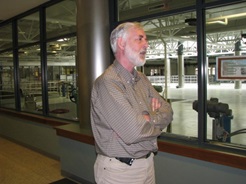Our Own Tim MacDonald on Tour with 22-CityView

By Karen Klinger
Anyone who wants to learn about the complex route that Cambridge’s drinking water takes from reservoirs to faucets would do well to start by walking around the 2,500-square-foot terrazzo map on the floor of the city’s treatment plant at Fresh Pond.
Created by local artists Mags Harries and Lajos Heder, the map of the city’s water pipes, ponds, fountains and pools takes up almost the whole lobby of the Walter J. Sullivan Water Purification Facility, completed in 2001 to replace an aging plant at the same location.
Throughout the floor are brass strips of different widths representing the 180-mile web of water pipes that spread out across the city from the Cambridge Common. At one end of the lobby is a 14-foot-tall transparent column of water representing Payson Park Reservoir in Belmont, an underground tank that temporarily holds treated, or “finished,” water from the plant.
Every day, between 12 and 16 million gallons of water is withdrawn from Fresh Pond, run through the plant and then pumped a half-mile uphill to an elevation of 176 feet at Payson Park, from which it flows by gravity to a central distribution point at the Common, providing the water pressure needed for it to wind up ultimately in homes, schools and offices.
To find out how all that water gets into Fresh Pond, a 155-acre glacier-carved kettle-hole lake, a visitor can go up to the second floor of the Sullivan plant, where a mural displays the watershed areas in the communities of Lincoln, Lexington, Weston and Waltham where Cambridge’s feeder reservoirs, Hobbs Brook and Stony Brook, are located.
As Tim MacDonald, the city’s manager of water operations, explained as he led a recent tour of the treatment facility, Fresh Pond is constantly replenished by a supply of water from the upper reservoirs and their associated dams, surrounded by 1,200 acres of protective woods and meadows.
MacDonald said the Hobbs Brook and Stony Brook reservoirs and Fresh Pond together hold about an eight-month supply of water but on top of that, “We also have backup from the MWRA (Massachusetts Water Regional Authority)” if a prolonged drought causes water levels to drop precipitously.
In fact, while many residents may not have realized it, he said they were drinking the same MWRA water that supplies much of the greater Boston region for three years during the construction of the Sullivan plant.
As MacDonald spoke, he was standing in a hallway that separates the 2,500-square-foot laboratory where 50,000 water samples are tested annually from the rest of the plant, where water from intake structures that extend into Fresh Pond goes through a series of processes that include aeration and the application of ozone to remove nasty things such as bacteria, viruses, protozoa and algae, as well as manganese that can tint the water red.
In the next step, the disinfectant process is continued by dissolving fine bubbles of ozone into the water and then removing it. Following that, any remaining organic compounds are taken out by “granular activated carbon” or GAC filtration that further “polishes” the water, eliminating whatever particles or color are left.
Finally, the water is chlorinated to kill any bacteria that still might remain and undergoes post-treatment chemical adjustment of pH and the addition of fluoride to prevent dental cavities, plus another chemical to disinfect residuals in pipes.
The end result, MacDonald is happy to note, is tap water that is every bit as healthful as store-bought bottled water, and for a small fraction of the cost. He recalled that in a taste-testing contest some years ago, Cambridge water did very well against pricey competitors.
For all of this, residents can thank the foresight of city fathers who acquired the Cambridge Water Works in 1865 and over the next 32 years annexed 570 acres of land from Belmont as a buffer for Fresh Pond, purchased Stony Brook in Weston and Waltham, obtained the rights to Hobbs Brook and built the Payson Park Reservoir.
In 1922, the city built what was then the largest and most technologically advanced water treatment plant in New England, but by the beginning of the 1990s it became apparent that its age and mechanical limitations, plus new regulations, mandated a replacement.
As MacDonald looked around the lobby of the current plant--named for a longtime city council member and former mayor—and beyond to the vista of Fresh Pond, he said he felt fortunate to be a part of the system. “This place and the whole operation—it’s a real gem,” he said.